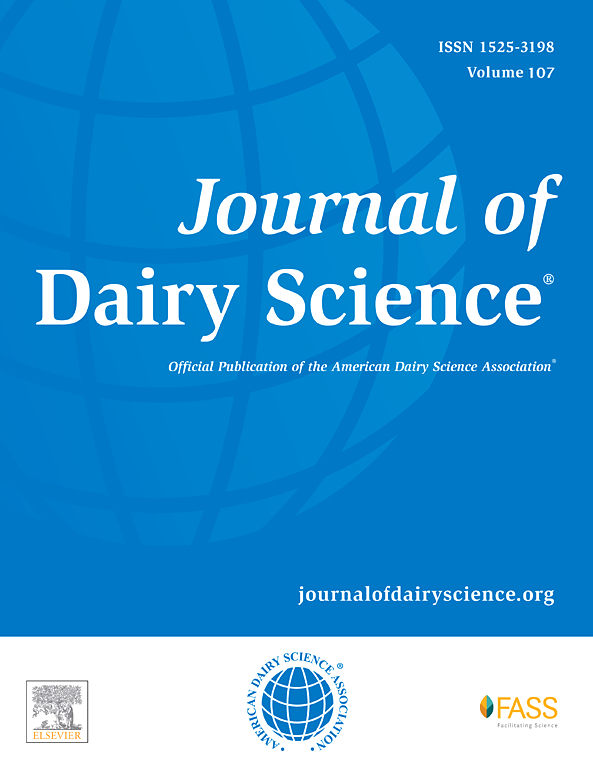Quantifying the impact of frequent diseases and syndromes on calf health using the opinions of producers and veterinarians: Toward dairy calf disability weights
IF 3.7
1区 农林科学
Q1 AGRICULTURE, DAIRY & ANIMAL SCIENCE
引用次数: 0
Abstract
The first objective of this study was to quantify the impact and disability weight (DW) of frequent diseases or syndromes of preweaning dairy calves using the perceptions of producers and veterinarians. The second objective was to compare the opinions of producers and veterinarians regarding the impact and DW of dairy calves' frequent diseases and syndromes. A survey was conducted to obtain demographic information and opinions of 39 dairy producers and 52 veterinarians on the impact of frequent disease and syndromes on calf health. Most of the producers (97.4%, 38/39) were clients of the ambulatory clinic at the Faculté de Médecine Vétérinaire de l'Université de Montréal in Saint-Hyacinthe, Québec, Canada. They were actively engaged in calf research projects. Québec veterinarians were contacted via email through their association. Additionally, veterinarians from the bovine ambulatory clinic and the bovine veterinary hospital at the Faculté de Médecine Vétérinaire de l'Université de Montréal were contacted directly via email. A visual analog scale, represented by a horizontal line ranging from 0 (no impact) to 10 (maximum impact; i.e., death or euthanasia), was used to estimate the impact of 9 frequent diseases or syndromes (diarrhea, dystocia, inadequate transfer of passive immunity, fracture, wound or abscess, arthritis, respiratory disease, umbilical infection, and congenital defect) on calf health following previously reported methods (using the most probable, and range of the perceived impact for each participant and disease). The DW values were obtained by converting the impact values to a probability density in a scale from 0 to 1 using BetaPERT methodology, a type of data distribution model. Average impact and DW were quantified for each frequent disease and syndrome. Average impact differed statistically across different diseases and syndromes. The highest average impacts were obtained for the presence of a fracture (6.49/10), arthritis (6.22/10), and congenital defects (6.03/10), whereas the lowest impact was observed for the presence of a wound or abscess (3.42/10). The opinions of producers and veterinarians were similar for most of the selected diseases and syndromes; however, statistical differences were observed for arthritis (producers = 5.13 vs. veterinarians = 6.88), umbilical infection (producers = 3.65 vs. veterinarians = 4.74), and dystocia (producers = 3.87 vs. veterinarians = 4.58). A strong correlation coefficient (0.72) was observed between the observed ranks of diseases and syndromes of producers and veterinarians. In conclusion, we quantified how frequent diseases and syndromes affect calf health. Producers and veterinarians mostly agreed on their impact. Estimating DW is a crucial first step in creating a health measure for dairy calves. Similar to humans, this metric will be important for health comparative analysis for producers, veterinarians, and industry.
利用生产者和兽医的意见量化常见疾病和综合征对小牛健康的影响:对奶牛小牛残疾体重的影响。
本研究的第一个目的是利用生产者和兽医的看法,量化断奶前犊牛常见疾病或综合征的影响和残疾体重(DW)。第二个目标是比较生产者和兽医对奶牛常见疾病和综合征的影响和DW的意见。进行了一项调查,以获取39名乳制品生产商和52名兽医关于常见疾病和综合征对小牛健康影响的人口统计信息和意见。大多数生产者(97.4%,38/39)是位于加拿大魁省圣亚辛特的蒙特尔大学(FMV, UdeM)的流动诊所的客户。他们积极从事小牛研究项目。我们通过协会的电子邮件联系了quemail的兽医。此外,通过电子邮件直接联系了牛门诊诊所和牛兽医医院的兽医。用水平线表示的视觉模拟量表,范围从0(无影响)到10(最大影响(即死亡或安乐死)),用于估计9种常见疾病或综合征(腹泻、难产、被动免疫转移不足、骨折、伤口或脓肿、关节炎、呼吸系统疾病、脐带感染和先天性缺陷)对小牛健康的影响,按照先前报道的方法(使用最可能的、以及对每个参与者和疾病的感知影响范围)。使用betaPERT方法将冲击值转换为0到1的概率密度,得到DW值。对每种常见疾病和综合征的平均影响和DW进行量化。不同疾病和综合征的平均影响在统计上有所不同。骨折(6.49/10)、关节炎(6.22/10)和先天性缺陷(6.03/10)的平均影响最高,而伤口或脓肿的平均影响最低(3.42/10)。养殖户和兽医对大多数选择的疾病和证候的看法相似;然而,在关节炎(生产者= 5.13 vs兽医= 6.88)、脐带感染(生产者= 3.65 vs兽医= 4.74)和难产(生产者= 3.87 vs兽医= 4.58)方面观察到统计学差异。养殖户与兽医所观察到的疾病和证候等级之间有很强的相关系数(0.72)。总之,我们量化了疾病和综合征影响小牛健康的频率。生产商和兽医大多同意它们的影响。估算乳牛重是制定犊牛健康措施的关键第一步。与人类相似,这一指标对于生产者、兽医和工业的健康比较分析非常重要。
本文章由计算机程序翻译,如有差异,请以英文原文为准。
求助全文
约1分钟内获得全文
求助全文
来源期刊

Journal of Dairy Science
农林科学-奶制品与动物科学
CiteScore
7.90
自引率
17.10%
发文量
784
审稿时长
4.2 months
期刊介绍:
The official journal of the American Dairy Science Association®, Journal of Dairy Science® (JDS) is the leading peer-reviewed general dairy research journal in the world. JDS readers represent education, industry, and government agencies in more than 70 countries with interests in biochemistry, breeding, economics, engineering, environment, food science, genetics, microbiology, nutrition, pathology, physiology, processing, public health, quality assurance, and sanitation.
 求助内容:
求助内容: 应助结果提醒方式:
应助结果提醒方式:


